Notes: Oldham Mumps opened on 1st November 1847 as a terminus station on the Lancashire & Yorkshire Railways Middleton to Oldham branch.
The branch had originally been opened as far as Oldham Werneth by the Manchester & Leeds Railway (M&LR) on 31st March 1842 to connect Oldham to the M&LRs Manchester to Leeds main line at Middleton. The Manchester to Leeds line had opened throughout on 1st March 1841. Oldham Werneth was on the edge of the town, and so the M&LR obtained an Act to extend the line a mile further on the 30th June 1845. A contract was let to George Thompson in October 1845, and work began straight away. On 8th July 1847 the M&LR changed its name to the Lancashire and Yorkshire Railway (LYR).
By 1850 Oldham Mumps was served by ten trains per day. These connected Oldham to Manchester Victoria, but many trains in the Manchester direction terminated at Middleton where passengers could catch onward connections to Manchester.
 |
On 12th August 1863 a further extension of the Middleton to Oldham line opened to goods services. This six-mile extension was to Rochdale, which was on the same Manchester and Leeds line as Middleton, and it effectively created a loop from Middleton to Rochdale via Oldham. On 2nd November passenger services were introduced on the new line to Rochdale. |
By this time Oldham Mumps, now a through station, was being served by twenty-four trains in each direction running between Rochdale and Manchester Victoria. Again some of the services started or finished at Middleton. In March 1864 the Royton branch opened from the Rochdale line, diverging at a point a few miles to the north of Mumps station. From 21st March 1864 passenger services began between Oldham Mumps and Royton.
The line from Middleton to Oldham Werneth had a very steep incline (the Werneth Incline) of 1 in 27. Until 1854 the incline had been cable-worked. Various proposals had been put forward to create a direct line from Werneth to Manchester that avoided the incline, but it was not until the LYR obtained an Act in 1873 that anything was done. The 1873 Act authorised the LYR to build a line from Thorpes Bridge Junction - which was on the Manchester to Leeds line, but closer to Manchester - to Oldham Werneth. A contract was let on 30th June 1875, and on 17th May 1880 the new line opened.
 |
In 1884 the LYR decided to rebuild Oldham Mumps station, probably because the original facilities were no longer large enough. They awarded a contract to Thomas Wrigley for £19,517 to build a new station, and at the same time to widen the line. The new facilities were ready by March 1887, with a single-storey entrance building on the west side of the line. It was constructed from yellow brick and had a canopy over its frontage. From the entrance building a subway connected through to a large island platform on which stood other single-storey buildings containing passenger and staff facilities. A large canopy provided protection from inclement weather. At each end of the island platform there was a single-track bay platform. Passengers accessed the station by means of a subway. On the south side of the passenger station there was a large goods station with numerous sidings, three goods sheds, gantry crane, stables, cattle pens etc. The entrance to the goods station was in Hamilton Street.
With the opening of the new line a route had been created from Thorpes Bridge to Rochdale, via Werneth, that eventually became known as the ‘Oldham Loop Line’. Trains serving Mumps continued to run between Manchester Victoria and Rochdale, but most of them now travelled via the newly-opened line. There were fifteen in each direction. A few services |
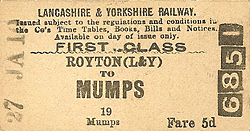 |
continued to run via the Middleton line.
On 1st January 1922 Oldham Mumps station became part of the London & North Western Railway (LNWR) when that company took over the LYR. However on the 1st January 1923 the LNWR was in turn absorbed into the London Midland and Scottish Railway (LMS).
In 1925 the LMS carried out improvements at the station which included demolition of a waiting room to allow the Manchester-end bay platform to be extended. Some steps were filled in, and a new waiting room was built. Ticket collectors’ booths were erected at the top of slopes that led to the subway. The work was carried out as the LMS had a plan to electrify the line between Mumps and Manchester which was never realised.
By 1938 Oldham Mumps station was still being served by fifteen local trains on the Manchester Rochdale axis. It also had twent- two services, many of them shuttles that ran to and from Royton. On Friday evenings a train to Glasgow and Edinburgh via Rochdale called at the station. On Sundays-only a train that originated at Royton and ran on to Blackpool Central via Manchester Victoria served Mumps, as did another that started at Milnrow and ran to Southport via Manchester Victoria.
 |
On 1st January 1948 Oldham Mumps became part of the nationalised British Railways (London Midland Region). During the last year of fully steam operated services in 1958 there were eighteen trains in each direction running between Manchester and Rochdale using the Thorpes Bridge route, and three Saturdays-excepted trains called that had originated from |
Middleton Junction and travelled onward to Rochdale. Interestingly there was only one Saturdays -excepted train that ran from Werneth to Middleton which had originated at Rochdale.
By the early 1950s the main entrance building was in a state of disrepair, and the station generally was looking shabby. The local press complained bitterly, and in 1955 British Railways announced that the station would be reconstructed. Design of the new facilities was undertaken by J Taylor Thompson, the Chief Civil Engineer of BR London Midland Region. The work was carried out by Gerrards of Swindon and cost £30,000. The new facilities included a single- storey brick-built entrance structure with large windows to provide plenty of light. The building had a flat roof. The station canopy was repaired and cut back, and electric lighting was installed throughout. The new facilities were completed on 3rd of August 1957.
 |
In June 1958 British Railways introduced Diesel Multiple Units (DMUs) onto the Oldham Loop. A Cravens-built type of DMU (later known as class 104) which had twin power cars used the line as they were easily able to cope with the steep gradients. The service pattern at Oldham Mumps was a train every twenty minutes to Manchester, via the Thorpes Bridge line, and northbound trains every twenty minutes. The northbound service destinations alternated with a service to Rochdale (every 40 minutes) and a service to Royton (every 40 minutes). Two Saturdays-excepted trains continued to call on their way to Rochdale from Middleton Junction, but there was no service in the other direction. In total there were twenty-nine trains between Manchester and Rochdale and twenty five between Manchester and Royton: this was the highest-ever frequency of service enjoyed by Oldham Mumps.
| The Reshaping of British Railways (Beeching Report) of March 1963 recommended the closure of the Royton branch to passengers but made no reference to the Oldham Loop or any of its stations. Nevertheless, September 1964 saw a decline in services calling at Mumps. The service between Manchester and Rochdale became irregular, with trains calling at |
 |
Mumps about every 45 minutes in each direction. Trains between Royton and Manchester Victoria were reduced to seven on weekdays in each direction, eight on Saturdays, and there were none on Sundays. From 7th September 1964 no trains operated from Middleton Junction. In 1966 further changes took place, including the closure of the Royton Branch on 18th April (as recommended by Beeching) but also Oldham Central station (which Beeching implied was to be retained) on the same day. The service pattern was altered so that trains ran between Manchester Victoria and Oldham Mumps, with fewer continuing onward to Rochdale. By 1968 the Mumps service had settled into a thirty minute frequency in each direction. Alternate northbound trains continued beyond Oldham Mumps to Rochdale giving only an hourly frequency to that town (although services were also provided to and from Manchester Victoria via Castleton).
It escaped the attention of the Beeching Report, however the British Railways Network for Development map of March 1967, published when Stanley Raymond was Chairman of the British Railways Board and Barbara Castle the Secretary of State for Transport, showed that Oldham Mumps to Rochdale would not form part of the ‘basic railway network’. Subsequently a footnote in the May 1972 passenger timetable advised that the Secretary of State had given consent to the withdrawal of passenger services between Oldham Mumps and Rochdale. However, by this date, the South East Lancashire North East Cheshire (SELNEC) Passenger Transport Executive (Greater Manchester Passenger Transport Executive – GMPTE - from April 1974) had stepped in and agreed to fund the continuation of the service.
 |
From the introduction of the May 1979 timetable trains that ran only as far as Oldham Mumps were extended to run to Shaw & Crompton. The thirty-minute interval service at Oldham Mumps was retained. In the May 1989 timetable a half-hourly service to Rochdale was introduced, with extra services at peak hours running to Shaw & Crompton |
By the mid-1980s the bay platforms had been taken out of use, and the remaining sidings were removed. Unlike other stations on the line Oldham Mumps kept its buildings and its canopies and retained its staff.
In the 1990s the main entrance building was demolished, and the station’s facilities were concentrated on the island platform.
In May 1995 the last alteration was made to the train services that called at Oldham Mumps. From this date Mumps was served by a half-hourly train in each direction between Manchester Victoria and Shaw & Crompton, and a half-hour frequency service between Manchester Victoria and Rochdale which ran as an express service between Mumps and Victoria.
| In the mid-1990s the GMPTE had been looking at extending its 1992-opened Metrolink tram system. One idea that had been considered as early as 1984 was to use the Oldham Loop as a means of extending tram services to Oldham and Rochdale. By the beginning of the 21st century plans had been drawn up, and a few |
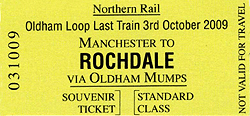 |
years later funding was in place to carry out the required works. To enable these works to go ahead the Oldham Loop had to close. Oldham Mumps station, along with all of the others on the line, closed on Saturday 3rd October 2009. For the first time since 1842 Oldham no longer had a railway, and Oldham probably achieved the distinction of being the largest town in Britain without a train service. A number of special services, including steam hauled trains ran on the last day to celebrate the line and its history. Many local people turned out to watch the last trains run. The last train to depart from Oldham Mumps station was the 23:25 Manchester Victoria to Rochdale service. Demolition began almost immediately, and by May 2010 there was nothing left of the station except the signal box which was demolished on 28th July 1010.
On the 13th of June 2012 the Metrolink tram line opened to a point just to the west of Oldham Mumps station. A temporary tram stop opened also to the west of the former station to provide a terminus for the line until a new tram/bus interchange facility was completed.
Tickets from Michael Stewart, Route map drawn by Alan Young
Other web sites: Lost lines, a selection of pictures of the Oldham Loop line taken on 30th September 2009, shortly before closure. Class 25s and Much More web site has a feature called Farewell to the Oldham Loop with 51 pictures taken in August 2009. Sam Dixon's UK National Rail, Heritage Rail & Former Rail web site with 124 pictures of the Oldham loop line take two days before closure. Tom Fenton's web site also has a feature Farewell to the Oldham Loop with 27 pictures taken in August 2009. Alan Perryman's Thistle 5 web site includes 93 pictures from the last day of the Oldham Loop.
Sources: The Oldham Loop – Part One – Manchester Victoria to Shaw & Crompton, Jeffery Wells, Foxline Publishing ISBN 1870119681 and The Lancashire & Yorkshire Railway Volume 2, John Marshall, David & Charles. ISBN 0715349066. Encyclopedia of British Railway Companies, Christopher Awdrey. Guild 1990. Regional History of the Railways of Great Britain Vol10 The North West, G.O. Holt, David & Charles 1986 ISBN 0946537348. The Lancashire & Yorkshire Railway – Volume 2 J. Marshall, David & Charles 1970. ISBN 0715349066. An Illustrated History of Oldham's Railways J. Hooper, Irwell Press 2006 ISBN 1871608198. Railways Across the Pennines Jenkins and Quayle, LBS 1990. Railway History in Pictures – The Lancashire & Yorkshire Railway, John Marshall, David & Charles 1977 ISBN0715374788. Additional source Alan Young
To see other stations on the Oldham Loop Line click on the station name:
Dean Lane, Failsworth, Hollinwood, Oldham Werneth, Oldham Central, Derker, Royton Junction, Shaw & Crompton, New Hey & Milnrow.
See also Royton
|

mumps_old5.jpg)

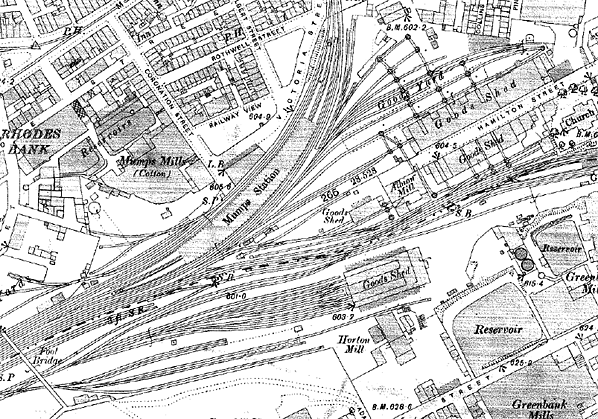
mumps_old6.jpg)
mumps_old2.jpg)
mumps_old14.jpg)
mumps_old12.jpg)
mumps36.jpg)
mumps19.jpg)
mumps26.jpg)
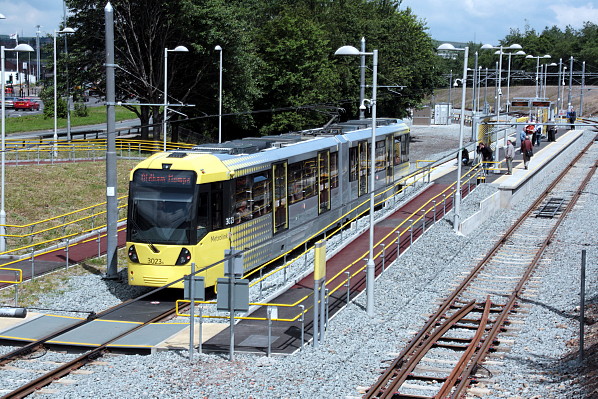








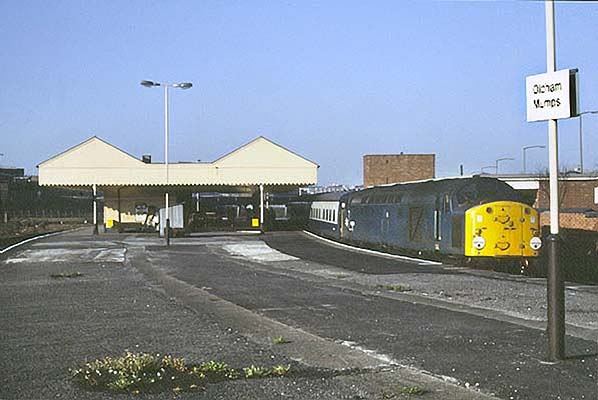

 Home Page
Home Page